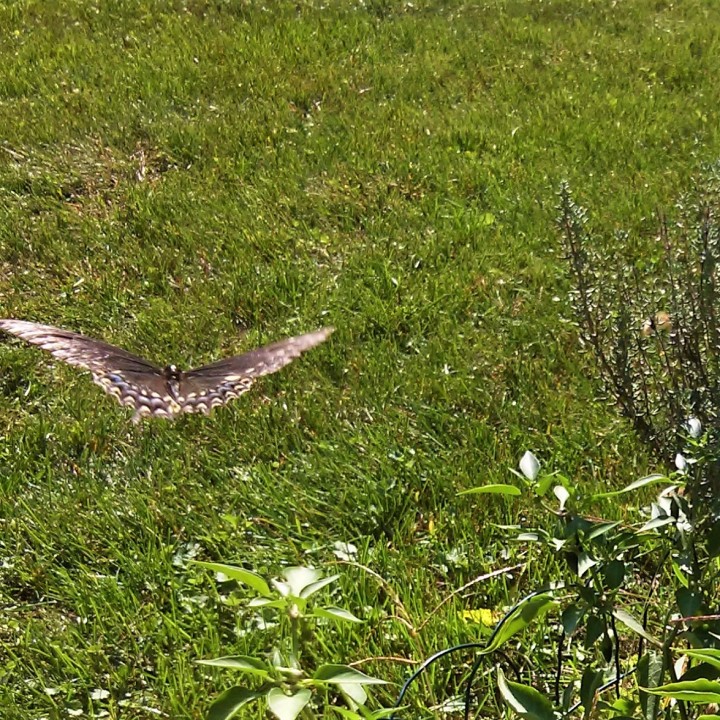
A few days ago, I was cleaning a garden bed, when I spotted a large butterfly fluttering around my herbs (photo above). It was extremely sunny and the little critter just paused for a short while, so I shot several photos hoping to get it in the frame:



Needless to say, the photos have poor definition, but I was able to identify it as an Eastern Black Swallowtail (Papilio polyxenes); they are not uncommon in my garden, but I thought it was a little late for an adult to be around. I checked about this species, and it happens to be non-migratory. For bird and butterfly lovers all over the North American subcontinent, migration is the quintessential theme right now; many species have begun their yearly journey from Canada and Northern USA to warmer sites in Southern USA and Mexico. One of the most studied migrating species is the Monarch Butterfly (Danaus plexippus); its migration pattern might seem to be in violation of any logic, since it is completed over four generations, and yet the butterflies follow the exact same rubric of locations and routes as their predecessors. This wonder of Nature continues to awe both entomologists and general public alike; in Mexico, The Monarch Butterfly Biosphere Reserve is a UNESCO World Heritage site.
The Black Swallowtail looks like a strong butterfly, and at least as large as the Monarch, so I wondered why they would choose to go into pupal stage and overwinter inside a chrysalis in Canada, instead of flying South like their cousins. I read this article explaining that migration is a mechanism triggered both by habitat conditions (such as overpopulation) and seasonal changes (like drop in temperatures), and that specific conditions generate different behavioural traits for different species, even when they are closely related. The article concludes with the observation that some migratory birds are already becoming sedentary, responding to local changes in temperature patterns, and due to urbanization.
I still thought it was kind of late to see an adult Black Swallowtail; should not the last summer generation of caterpillars be getting ready for the pupal stage by now? I was sad to ponder whether the gift of seeing this lovely butterfly so late in the season was a sign of global warming and too much urban development; I just hope we do not start spotting Monarchs in the fall around Southern Ontario.








I love butterflies. Thanks for the photos 🙂
LikeLiked by 1 person
that’s a cool butterfly. never saw it before. Thanks for the info. I didn’t know that about butterflys that they stay holed up in their chrysalis all winter long. I wonder how they don’t freeze. Maybe that’s how nature keeps their numbers down.
LikeLike
Yeah, it is pretty neat, how different species have their adaptations.
LikeLiked by 1 person
I don’t recall seeing one of these. We get the yellow tiger swallowtails here. Interesting post.
LikeLiked by 1 person
We have the Eastern version of the tiger ones over here, as well. Thank you, Eilene!
LikeLiked by 1 person
Beautiful butterfly. I didn’t realize some butterflies didn’t migrate.
LikeLike
Yes, it’s amazing that they overwinter in their cocoons
LikeLiked by 1 person
They must find some very sheltered places
LikeLike
I guess so, I leave my parsley patch untouched until spring, just in case there are some there. People who like to observe the full life cycle put the cocoons in the refrigerator to overwinter; apparently warmth is the real problem because the butterflies might emerge prematurely.
LikeLiked by 1 person
Okay, so leaving my herb garden untouched for the winter might be a good idea! Thanks for the information!
LikeLiked by 1 person
Glad to be helpful!
LikeLiked by 1 person
Better late than never as the adage goes. But what an eye opener your well founded discussion is -that our planet it’s such a mess that we’ve urbanized ton the extent that our growth has confused birds.
We built machines to have more time to think and less time in the fields or in factories. We’ve built machines to think for us so now what’s left to do? Watch as our inventions of our consciousness destroy our planet and ourselves? Maybe instead of investing in getting people off of the universes dumping ground, companies like SpaceX and Amazon and Virgin should invest in fixing our global climate change mess first.
Gorgeous butterfly. Saw my first and only monarch this year just a week ago. They migrate from Santa Cruz and it’s usually right around the sane time as your guy did…he sat on my shoulder as I was telling a friend about my grandma who died when I was five. Maybe she came by to remind me she’s still around me.
Thank you for following my blog – cancerbus.com
I need all the people I can to help drive metastatic breast cancer awareness – 90% of all cancers are environmental not genetic. That’s proof of the butterfly effect!
🦋🦋🦋🦋
Ilene
LikeLike
Thank you for your well thought comment, Ilene! 90% environmental? Talk about cause and effect!
Very beautiful reflection about the butterfly on your shoulder.
Today I saw a Black Swallowtail caterpillar on my parsley; I am crossing my fingers for the little guy to make it through winter.
LikeLiked by 1 person